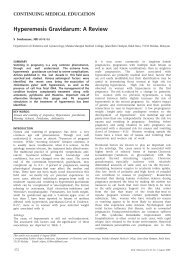Understanding Hyperemesis Gravidarum - Medical Journal of ...
Understanding Hyperemesis Gravidarum - Medical Journal of ...
Understanding Hyperemesis Gravidarum - Medical Journal of ...
Create successful ePaper yourself
Turn your PDF publications into a flip-book with our unique Google optimized e-Paper software.
although some studies indicate poor relationship<br />
between estrogen levels and hyperemesis gravidarum<br />
hence the role <strong>of</strong> estrogen in this condition remains<br />
unclear. Serum progesterone levels also peak in first<br />
trimester <strong>of</strong> pregnancy; progesterone alone or in<br />
combination with estrogen may cause gastric<br />
dysrhythmias by decreasing the gastric smooth muscles<br />
contractility. Serum prostaglandin E2 CPGE2) levels<br />
were found to be higher during symptomatic period <strong>of</strong><br />
hyperemesis gravidarum. Placental PGE2 synthesis is<br />
stimulated by HCG, the latter usually peaking between<br />
9th to 12 weeks <strong>of</strong> gestations, which may explain the<br />
symptoms <strong>of</strong> hyperemesis gravidarum!,2. HCG has a<br />
thyrotropic action and hyperemesis gravidarum is more<br />
common in pregnancies with high HCG and exhibiting<br />
transient self-limiting hyperthyroidism. Anti thyroid<br />
drugs in this situation is usually unnecessary 1l,<br />
Recent studies suggested that chronic Helicobacter<br />
pylori infection might play a role in hyperemesis, H.<br />
pylori seropositivity was present in up to 60% <strong>of</strong><br />
pregnant mothers compared with 50% in the general<br />
population, However, the seropositivity did not<br />
correlate with gastrointestinal symptoms!,2. H. pylori<br />
infection has been found in cases <strong>of</strong> persistent vomiting<br />
in pregnancy not responding to supportive. treatment.<br />
However, endoscopic diagnosis should be performed<br />
after initial non-invasive test are negative 12,<br />
Psychological factors associated with hyperemesis<br />
gravidarum is by far the oldest theory. Some<br />
researchers also postulated that psychological factors<br />
might be responsible for hyperemesis gravidarum. In<br />
one study, it was suggested that women with<br />
hyperemesis have hysteria, excessive dependence on<br />
their mothers and infantile personalities!,5.<br />
Psychoanalytic theories describe hyperemesis as a<br />
conversion or somatization disorder or inability <strong>of</strong> the<br />
mother to cope with excessive life stress. However<br />
these findings are not conclusive due to a lack <strong>of</strong> robust<br />
data to support these associations'.<br />
Persistent nausea and vomiting has been associated<br />
with food substances. <strong>Hyperemesis</strong> gravidarum is<br />
more common in populations where meat, fish, poultry<br />
and eggs are commonly consumed; in contrast nausea<br />
and vomiting is less common in cultures where plant<br />
foods such as corn are consumed. Olfactory sensitivity<br />
may play a role in pathogenesis <strong>of</strong> hyperemesis<br />
gravidarum 5 ,<br />
Serotonin C5-hydroxytryptamine) receptors which are<br />
found in the central nervous system and gut may play<br />
Med J Malaysia Vol 60 No 3 August 2005<br />
<strong>Understanding</strong> <strong>Hyperemesis</strong> <strong>Gravidarum</strong><br />
a role in vomltmg. Drugs like ondansetron, a 5-HT<br />
receptor blocker are commonly used against vomiting<br />
induced by chemotherapy. However, hyperemesis<br />
gravidarum has not been associated with increased<br />
serotonin secretion disputing a widespread use <strong>of</strong> 5-HT<br />
receptor blockers in hyperemesis gravidarum 13 ,<br />
Therefore, the pathogenesis <strong>of</strong> hyperemesis gravidarum<br />
seems to be multifactorial. Women with vomiting in<br />
pregnancy are also found more commonly have history<br />
<strong>of</strong> oral contraceptive sickness, motion sickness,<br />
migraine, a positive family history <strong>of</strong> hyperemesis and<br />
canying a female fetus.<br />
Complications <strong>of</strong> <strong>Hyperemesis</strong> <strong>Gravidarum</strong><br />
Maternal Complications<br />
Persistent severe vomiting <strong>of</strong> mother can lead to<br />
dehydration, electrolyte imbalance and ketosis. More<br />
serious conditions include esophageal tear or rupture,<br />
splenic avulsion, pneumothorax and peripheral<br />
neuropathy due to B6 and B12 deficiency 5,6,<br />
Wernicke's encephalopathy has been associated with<br />
treatment <strong>of</strong> hyperemesis gravidarum with intravenous<br />
dextrose replacement without thiamine supplement.<br />
Central pontine myelinolysis associated with Wernicke's<br />
encephalopathy has been reported 5 . The incidence <strong>of</strong><br />
maternal death due to hyperemesis gravidarum is rare,<br />
In Malaysia two cases <strong>of</strong> maternal death due to<br />
<strong>Hyperemesis</strong> gravidarum were reported between 1991<br />
2000 6 ,<br />
Fetal complications<br />
Uncomplicated nausea and vomiting have been noted<br />
to have more favourable outcome <strong>of</strong> pregnancy than<br />
those without vomiting, these includes less cases <strong>of</strong><br />
miscarriages, preterm deliveries and stillbirths.<br />
However uncontrolled hyperemesis gravidarum has<br />
been associated with fetal growth retardation and fetal<br />
death, In one report it was stated that up to 32% <strong>of</strong><br />
infants whose mothers experienced weight loss due to<br />
hyperemesis were less than 10th percentile for the<br />
gestational weight at birth!,', A low risk <strong>of</strong> central<br />
nervous system and skeletal malformations was noted<br />
in children born <strong>of</strong> mothers with hyperemesis<br />
gravidarum 2 • <strong>Hyperemesis</strong> gravidarum may also be a<br />
risk factor for testicular cancer in the male <strong>of</strong>fspring 2,<br />
Clinical Evaluation<br />
History<br />
<strong>Hyperemesis</strong> gravidarum more commonly occurs in<br />
primigravida. Most <strong>of</strong> these patients present at the<br />
maternal antenatal clinic or emergency department<br />
depending on the severity <strong>of</strong> the symptoms. When a<br />
multipara presents with hyperemesis gravidarum, they<br />
395









